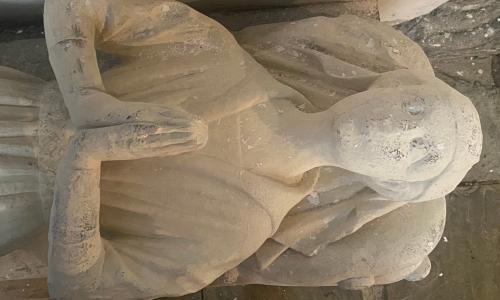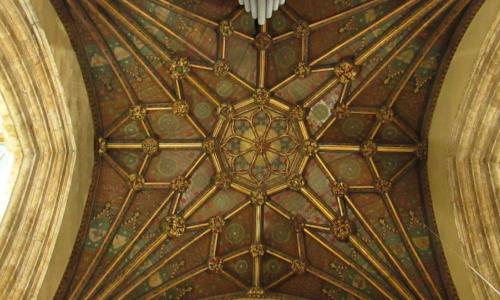Early history
The Churchyard surrounding Holy Trinity was consecrated in the 1300s. An early grave marker from this period was found in excavations. From this date until the 1850s, it was used to bury the city’s dead.
In the Middle Ages, the wealthiest people were usually buried in stone or lead coffins in vaults inside the church. A stone coffin from this time, found under the floor in the 1830s, can be seen in the North Transept. The less wealthy were buried either in wooden coffins, or sometimes just a cloth winding sheet, pinned or tied in place (shroud-pins are often found in archaeology). It was common to clear churchyard graves once bodies had become skeletons, and store the bones in a charnel house or ossuary. What mattered then was praying for the dead, to help them get through a place called Purgatory – believed to be a kind of ‘spiritual assault course’, full of painful ordeals, where they worked off their sins in order to get into Heaven.
This belief was overturned by the Reformation in the 16th Century. Protestant teaching was that Purgatory did not exist – it was not in the Bible – so praying for the dead ended. The grave was now seen as a permanent place of rest and sleep until the Last Judgement. As a focus for memory, too, having a grave with a headstone became more important if you could no longer light a candle for the dead person’s soul or have Mass said for them. Wooden coffins and permanent headstones became more widespread, and because graves were no longer regularly cleared for charnelling, soil levels built up. Overcrowding became a problem, especially as more people moved into towns to work in new industries.
By the early 1780s, the churchyard was seen as having distinct areas: the North Ground, the Ten Groat Ground, and the Quire (Choir) Yard (on the South Side of the Chancel). Part of the Quire Yard was known as the Vicar's Ground and seems to have been the preferred burying place for members of the clergy and their families.
By the late 1760s plans were being discussed for a new burial ground outside the city walls. The graveyards at Holy Trinity and St Mary’s in Lowgate could no longer accommodate the growing population when they died. New burial grounds were opened: for St Mary's, one in Trippet, and for Holy Trinity, one in Castle Street, which opened in 1785 after the demolition of the walls. The new Church of St John (now site of Ferens Art Gallery) had burial vaults within it, which were expensive (3 guineas – £3 and 3 shillings – per person). A lot of long-established Hull families continued to use their burial plots and vaults in the churchyard or within the church, however.
Sometimes the “gravemaker” had to clear away soil to make space for new burials and to keep the ground level. As early as the 1700s we have a record of him being paid to move soil. At this time the graveyard was rented for pasture to bring income to the church and to keep the grass short.
Even though its use declined during the 1800s, the churchyard presented a health risk to the city. Nowadays, bodies are buried “six feet under” the ground. However, some burials at Holy Trinity had risen so close to the surface that newspaper reports describe children playing with the bones that poked through, or had been disturbed through the digging of new graves. Wealthier people were buried more deeply and securely, sometimes in a vault – a shaft, perhaps lined with brick or stone – into which coffins were slotted, with a stone to cap it.
In 1847 Milner described it in graphic detail for all of Hull to see:
"It is crowded every where with bones and coffins, some of the latter within a foot of the surface; the ground as may readily be imagined, is one mass of decomposed flesh and blood: it is raised two or three feet above the level of the adjoining streets by interments, notwithstanding those streets are now higher considerably than they formerly were. Holy Trinity is situated in the Market-place, and entirely surrounded by dwellings — at the west, a row of houses overlooks the ground, and in summer months, offensive smells are complained of."
At this time, illness was thought to be caused by miasma – bad smells. In 1846, a government inspector’s report made its way to the local newspaper describing his encounter with the gravedigger – known as a Sexton.
1840s onwards
As the city centre changed, parts of the graveyard were sold to the city council so that the market area at the west end could be expanded. Graves were moved aside. We found a number of these, called charnel pits, where many skeletons are reburied together, during the excavations in 2016.
The Crypt
The crypt was built in the 1840s to enable further bodies to be buried underneath the nave. This would bring in income to Holy Trinity, and was a rival to the commercially-run cemetery opened in 1846 at Spring Bank. One of the last people recorded as buying a vault in the Church was the solicitor and local historian Charles Frost. He bought a large family vault in the newly constructed crypt underneath the nave, but may never have used it. Charles Frost’s payment receipt reads
"Received of C Frost 21 May 1847 £15/15/0 (i.e. 15 Guineas) For the Purchase of a Vault in the North Ile (i.e. Aisle) with the understanding that Mr Frost shall have the Power to sell the same if he thinks proper"
In 1855 a law was passed to ban burials inside or under churches. The new crypt, which had only about twenty burials in it, was closed and became used for storage. When Mr Frost died in 1862, he was buried at Spring Bank Cemetery.
During World War II the crypt was used as an air raid shelter until the single exit made it unsafe.
2016 excavations
When the Trinity Square landscaping project took place, a large number of bodies were carefully and respectfully moved to Holy Trinity’s crypt to be reinterred there. Only one brick vault could be linked to an owner through identification of a coffin plate. This was William Westerdale, a block and mast maker who had a huge influence on shipping in Hull. His vault was against the wall of the houses which many years before had formed half of King Street.
Today the graveyard is a tranquil and pleasant place to sit and reflect. It is cared for jointly by Hull Minster and Hull City Council. A number of surviving monuments have been placed there: you can see stones commemorating a wide range of people, mainly from the 18th and 19th Centuries, including the family of Mayor John Porter, and a young soldier, James Gordon Ogle, who had fought at Waterloo.




